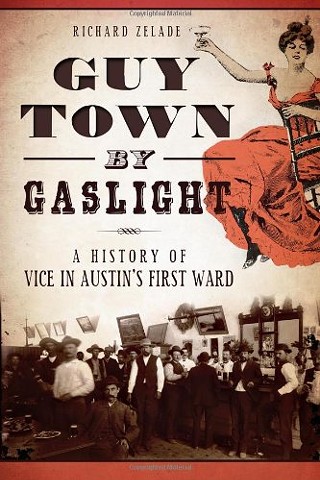'Guy Town by Gaslight'
New book digs up the dirt on Austin's scandalous 'hood of old
By Robert Faires, 1:00PM, Wed. Jul. 16, 2014
Why does no one talk about the Hookers' Balls?
In a town so proud of its contrarian, hedonistic ways, you'd think two public soirees hosted by madams and sanctioned by the city would've passed into local legend. But I only learned of this lost Austin weirdness in Guy Town by Gaslight, a book about that notorious neighborhood.
If you're unfamiliar with Guy Town, you can acquaint yourself with its whole sordid, fascinating history here, but suffice to say that it was party central – make that vice central – in Austin for more than 40 years between the end of the Civil War and the start of World War I. Officially known as the First Ward – roughly the same area as today's Warehouse District: the river north to Sixth Street, Congress on the east to West on the west – Guy Town was home to Austin's largest cluster of saloons and brothels, along with places to gamble and the odd opium den. If you were looking to seriously unwind in 19th-century Austin, this was the 'hood to do it, and people did, with the expected collateral activities. As Ian Quigley noted in these pages in 2001, "Brawling, singing, 'vile talk,' and 'abusive language' were common. Knives were pulled, bottles broken, guns fired."
Author Richard Zelade dug deep to recover the decades of depravity in what could accurately be called the Whorehouse District, reading every existing Austin newspaper from 1839 to 1896. In them, he discovered just how rowdy and raunchy the First Ward was, not only in general terms but in personal terms. He came to know the individuals who lived and worked there, as well as the visitors who got drunk, got high, got off, and got arrested, and in Guy Town by Gaslight, he salvages their histories. He introduces readers to such characters as "Mexican" Charley Cunio, an Italian immigrant who ran what was arguably the most riotous and unruly saloon in this none-too-decorous neighborhood and who, despite his illiteracy, was slicker at maneuvering out of legal woes than many an attorney in the capital city; the Burlage brothers, Chip, Joe, and Alf, a trio of unsavory con men who fleeced locals, wide-eyed rubes from the country, and even, in the case of Alf, their own sister with scams ranging from rigged bets to the false report of a child's demise; Lottie Stotts, the so-called "Queen of the Toughs," a prostitute renowned for her temper, pugnaciousness, and arrest record, and of whom it was written: "Of all the hard characters in Austin, she will easily take the blue ribbon for innate deviltry and general cussedness;" and Georgia Fraser, the well-to-do madam who hosted the first Hookers' Ball on March 31, 1886, for which she issued special invitations to young men around town and where the "evil-minded, unconscionable inmates" of the area's houses of ill repute "were permitted to publicly occupy a public hall and engage in wild, dissolute Circean orgies." (That was, reportedly, a lily-white affair. A similar ball on the following night was mixed-race, and Zelade theorizes that it may have been thrown by Laura Hall, who ran "Mahogany Hall," Guy Town's leading whorehouse of color.) The author even makes note of Austin's first recorded drag queen, an unnamed foreigner of slight build, dark complexion, and long brown hair, who was arrested in Guy Town in November 1874 wearing a calico dress, corset, hoops, bustle, and towels stuffed into the bodice to give his bust a boost.
Zelade clearly relishes sharing these figures' stories and re-creating the atmosphere of this lawless yet colorful period in Austin's past. It's evident in his prose, which takes on some of the antique sheen of the newspaper accounts from which he quotes at length. He adopts many of the slang terms and euphemisms of the day and dishes them out like scoops of ice cream. Just note a few of his terms for a "working woman" in Guy Town: fille de joie, cherie, demimonde, frail one, spoiled dove, dollar darling, nymph du pave. His intent is not to make light of the crime, poverty, misery, and violence that are woven through the tales of this community; those ills are treated with sufficient gravity. Rather, he's meeting the material on its own terms, channeling the language and spirit of the past to bring us closer to it, to get the blood flowing in these dusty figures of a distant age. You may come away from this visit from Guy Town with some relief that Downtown isn't quite so riotous anymore, but you'll no longer be able to think of late 19th century Austin in the sepia tones and stillness of an old photo. Even by gaslight, our town was vibrantly, thrillingly, crazily alive.
Richard Zelade will read from and sign copies of Guy Town by Gaslight Wednesday, July 16, 7pm, at BookPeople, 603 Lamar; Saturday, July 26, 2pm, at Barnes & Noble Arboretum, 10000 Research; and Tuesday, July 29, 6:30pm, at the Austin History Center, 810 Guadalupe.
A note to readers: Bold and uncensored, The Austin Chronicle has been Austin’s independent news source for over 40 years, expressing the community’s political and environmental concerns and supporting its active cultural scene. Now more than ever, we need your support to continue supplying Austin with independent, free press. If real news is important to you, please consider making a donation of $5, $10 or whatever you can afford, to help keep our journalism on stands.
Sept. 24, 2021
Sept. 17, 2021
Guy Town by Gaslight, Richard Zelade, Ian Quigley









